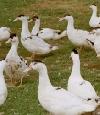Les omega-3 dans l’alimentation de gavage du canard : vers une meilleure maîtrise de la de la qualité technologique du foie gras
Use of dietary linseed to improve technological qualities of the
-
-

Table 1 : Fatty acid profile of samples of ducks assigned to the different diets

Les omega-3 dans l’alimentation de gavage du canard : vers une meilleure maîtrise de la de la qualité technologique du foie gras
Previous
Next
Context
A first experiment had shown an improvement of the fatty acid (FA) composition of the foie gras with the use of extruded linseed during the force-feeding period. A beneficial effect of the linseed supplementation on the lipidic rendering was suspected because of the higher omega-3 fatty acid level in the liver that could lead to greater cell membrane elasticity.Objectives
The experiment was studying the impact of extruded linseed supplementation during the force-feeding period on "lipidic rendering" (called "fonte lipidique", in french), who was the main technological problem that occur in "foie gras" production. The lipidic rendering result from the heat treatment of the "foie gras" and is prejudicial to both visual and organolpetic qualities of this product.Results obtained
Liver weight was similar among diets (± 530 g/bird). The sensory test showed no adverse effect of linseed supplementation on the criteria selected. The linseed diet improved the fatty acid profile by an increase in n-3 PUFA but the proportion of these fatty acids remained relatively low in liver of overfeeding ducks (Table 1). The other FA proportions showed no or minor changes between diets. This is due to the fact that de novo hepatic lipogenesis prevailed over dietary lipid intake to modulate lipid composition of tissues in overfed waterfowl. A reduction of lipidic rendering was observed during the "foie gras" production chain. The production chain index mesured at the day of slaugthering was much lower for the experimental diet (0,5 vs 3,5% for the control diet). After one day, this index raised appreciably for the foie gras of the two treatments but the initial difference of 3 points was preserved (9,7 vs 12,8% respectively for the "experimental" and "control" treatments). Moreover, the laboratory index confirm this observation (36 vs 41% respectively for the "experimental" and "control" treatments) even if this difference is not significant (p value = 0,23). There was an opposite relationship between the docosapentaenoïc acid content (DPA – C22:5 n-3) and the laboratory index of the foie gras (figure 1). We supposed that the higher n-3 PUFA content in the foie gras with linseed diets would give more elasticity to the hepatic cell membrane and, by this fact, would reduce the lipidic rendering who is prejudicial to the "foie gras" quality. A study financed by The RW-DGA-IG3 (Direction de la Qualité des produits) will be performed to confirm this assumption, specially with the observation of the changes that would occur in the FA profile of phospholipids. Contribution
CRA-WPartners
University of Ghent Louvain Catholic University Gembloux Agricultural University UPIGNAC Moulin Hick MR-W, Department of Development and Extension CRAW off coordinator
Dr Ir Nicole Bartiaux-Thill Inspecteur Général Scientifique CRA-W Rue de Liroux, 8 5030 Gembloux Email : bartiaux@cra.wallonie.be Funding




